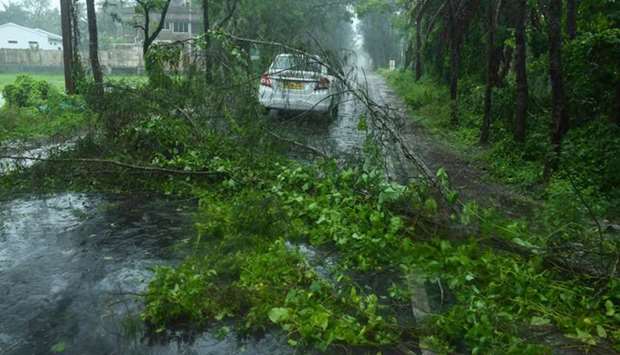A powerful cyclone pounded eastern India yesterday, killing at least 10 people and destroying thousands of homes, officials said, leaving authorities struggling to mount relief efforts amid a surging coronavirus outbreak.
West Bengal took the brunt of Cyclone Amphan, which barrelled out of the Bay of Bengal with gusting winds of up to 185kmh per and a storm surge of around 5m.
Chief Minister Mamata Banerjee said at least 10 people had died in the state, and two districts completely battered by one of the strongest storms to hit the region in several years.
“Area after area has been devastated. Communications are disrupted,” Banerjee said, adding that although 500,000 people had been evacuated, state authorities had not entirely anticipated the ferocity of the storm.
With rains continuing, she said the hardest hits areas were not immediately accessible.
Federal authorities said they could only make a proper assessment of the destruction today morning.
“We are facing greater damage and devastation than the Covid-19,” Banerjee said, referring to the disease caused by the novel coronavirus, which has so far killed 250 people in the state.
“We don’t know how to handle it,” she said.
In West Bengal’s capital city, Kolkata, strong winds upturned cars and felled trees and electricity poles.
Parts of the city were plunged into darkness.
An official in the adjoining Hooghly district said thousands of mud homes were damaged by raging winds.
Embankments were also breached in Sundarbans delta, where weather authorities had said the surge whipped up by the cyclone could inundate up to 15km inland.
The ecologically-fragile region straddling the Indian-Bangladesh border is best known for thick mangrove forests that are a critical tiger habitat, and is home to around 4mn people in India.
On the Sundarbans’ Ghoramara island, resident Sanjib Sagar said several embankments surrounding settlements had been damaged, and some flooding had started.
“A lot of houses have been damaged,” he said.
Anamitra Anurag Danda, a senior fellow at the Observer Research Foundation think-tank who has extensively studied the Sundarbans, said that embankments across the area may have been breached.
“The cyclone surge coincided with the new moon high tides. It is devastation in the coastal belt,” he said.
Two other fatalities were reported by media, including an infant crushed when the mud wall of the family’s hut collapsed in heavy rain in Odisha.
Amphan is the first “super cyclone” to form over the Bay of Bengal since 1999.
That cyclone left nearly 10,000 dead in Odisha, eight years after a typhoon.
While the frequency and intensity of storms have increased – blamed partly on climate change – casualties have fallen thanks to faster evacuations, better technology and more shelters.

A car drives past fallen tree branches along a road in Digha, West Bengal, yesterday.


